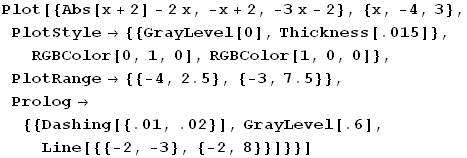A trick for plotting sums of absolute value functions.
Once you know a what's going on with absolute values, you can find some shortcuts for plotting them. Of course, we don't get license to take shortcuts until we've taken a few "longcuts". (You know how we are about that.)
As an example, suppose we want to plot the graph of y=f(x), where
f(x) = |x+2| - 2x.
It is plotted below. But we need to be able to understand why it looks this way. Why the bend where x=-2, for instance? (Notice that we are not using a "true" scale for our horizontal and vertical.)
In[59]:=
![]()
![[Graphics:../HTMLFiles/index_2.gif]](../HTMLFiles/index_2.gif)
Out[59]=
![]()
Think about the definition of absolute value:
|t| = {
t
if
t≥0
-t
if
t<0
This means that we have
|x+2| = {
x+2
if
x+2≥0
-(x+2)
if
x+2<0
and this simplifies to
|x+2| = {
x+2
if
x≥-2
-x-2
if
x<-2.
Now we'll add the term 2x into the mix. (We note that 2x doesn't care if x≥2 or not!) So
|x+2| - 2x = {
(x+2)-2x
if
x≥-2
(-x-2)- 2x
if
x<-2.
Simplifying gives
|x+2| - 2x = {
-x+2
if
x≥-2
-3x-2
if
x<-2.
This means that our function f(x) = |x+2|-2x is identical to the piecewise-linear function
f(x) = {
-x+2
if
x≥-2
-3x-2
if
x<-2.
Below we'll plot the line y = -x+2 in green, and the line y = -3x-2 in red.
In[71]:=
![Plot[{-x + 2, -3x - 2}, {x, -4, 3}, PlotStyle→ {RGBColor[0, 1, 0], RGBColor[1, 0, 0]}, PlotRange→ {{-4, 2.5}, {-3, 7.5}}]](../HTMLFiles/index_4.gif)
![[Graphics:../HTMLFiles/index_5.gif]](../HTMLFiles/index_5.gif)
Out[71]=
![]()
If we now throw in our absolute value function, you can see what's happening. Look below and notice the "split" at x=-2, just as we have in the piecewise-defined version of the function above. We only get the "green" part, the line y=-x+2, when x≥-2. When x<-2 we get the "red" part, the line y=-3x-2.
In[77]:=

![[Graphics:../HTMLFiles/index_8.gif]](../HTMLFiles/index_8.gif)
Out[77]=
![]()
Here's a better version, including a "true" aspect ratio (equal horizontal and vertical scaling).
In[79]:=

![[Graphics:../HTMLFiles/index_11.gif]](../HTMLFiles/index_11.gif)
Out[79]=
![]()
If you think about what just happened, you can see that when adding absolute values of linear functions to other linear functions, we'll always get a piecewise-linear function. Also, we'll get a "split" or "vertex" wherever the function inside the absolute value is zero. Knowing this in advance, we can "cheat"...
In the example above, we see that our vertex occurs where x+2=0, or where x=-2. Recalling that our function is f(x) = |x+2| - 2x, we see that the y-value at x=-2 will be f(-2) = -4. So the point (-2,-4) will be on our graph.
To the right of this point (i.e., where x>-2) we get a straight line, so we pick any value of x>-2, an easy one being x=0. Since f(0)=2, we have the point (0,2).
Looking left of x=-2 (i.e., where x<-2), we can take x=-3, say. We get f(-3) =|-3+2|-2(-3)=1+6=7, so (-3,7) is on our graph.
Plotting these three points, (-2,4), (0,2), (-3,7), on a graph and "connecting the dots" we get our picture.
In[74]:=
![Plot[Abs[x + 2] - 2x, {x, -4, 3}, PlotRange→ {{-4, 2.5}, {-3, 7.5}}, Epilog→ {PointSize[.03], Point[{-2, 4}], Point[{0, 2}], Point[{-3, 7}]}, AspectRatio→Automatic]](../HTMLFiles/index_13.gif)
![[Graphics:../HTMLFiles/index_14.gif]](../HTMLFiles/index_14.gif)
Out[74]=
![]()
| Created by Mathematica (June 17, 2006) |